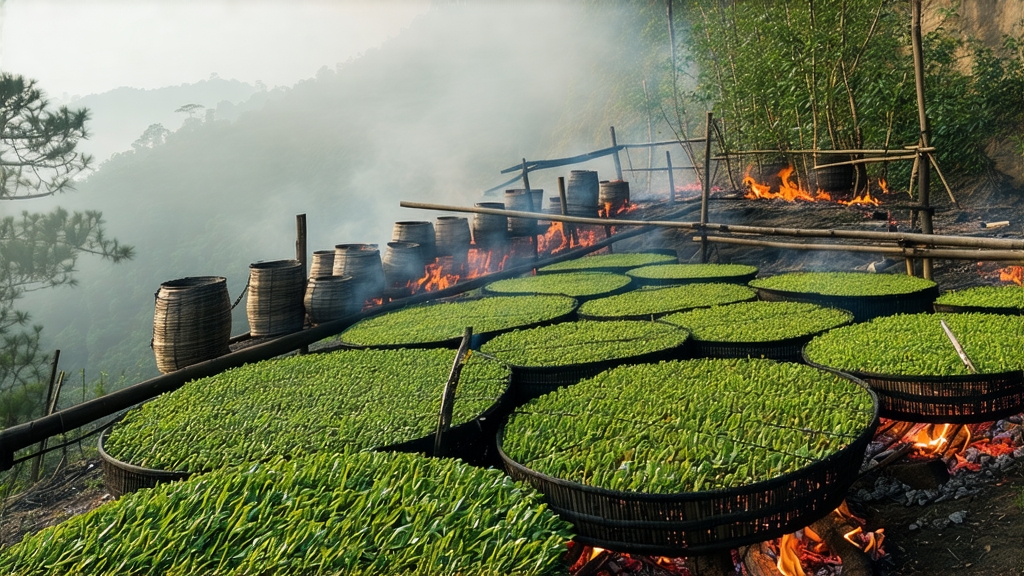
When European merchants first tasted a black tea from the Wuyi Shan in 1604, they recorded an intoxicating sweetness “like incense from Cathay.” That tea was Lapsang Souchong—today celebrated as the earliest black tea ever created and the prototype that inspired every subsequent black tea from Assam to Ceylon. To understand Chinese hong cha (red tea) is therefore to begin with Lapsang Souchong, a leaf whose history is woven into global trade routes, imperial banquets, and the very vocabulary of wine-like tasting notes now common in specialty coffee.
Historical Roots
Local legend credits the accidental birth of Lapsang Souchong to Qing-dynasty soldiers quartered in Tongmu village. While passing through during harvest season, their horses trampled fresh leaves left on bamboo trays. To salvage the crop, farmers rushed the bruised leaf to the drying shed where pinewood was burning overnight. The smoke permeated the tea, yielding an unexpectedly mellow liquor with a fragrance of longan fruit and resin. Monks from nearby Wuyi temples carried the tea to Xiamen port, where Dutch buyers shipped it to Amsterdam as “bohea” (a corruption of “Wuyi”). By 1662, when Catherine of Braganza introduced tea drinking to the English court, Lapsang Souchong was already the prestige leaf locked in iron-bound tea chests labeled “Souchong—best grade.”
Terroir and Micro-climate
Authentic Lapsang Souchong can only be produced inside the 565 km² core protection zone of the Wuyi Mountain UNESCO site, Fujian Province. The region’s danxia landform—purple-red sandstone cliffs—stores daytime heat and releases it at night, shortening the oxidation window and concentrating sugars. Frequent mountain fog filters sunlight into a soft, diffused glow, encouraging the synthesis of linalool and geraniol, the same floral volatiles found in Muscat grapes. Soil is thin, mineral-rich, and acidic (pH 4.5–5.0), forcing tea bushes to struggle and thus deepen flavor. Two indigenous cultivars dominate: Xiao Ye Zhong (small-leaf) and Cai Cha (mixed-color), both descendants of wild Camellia sinensis var. sinensis first documented in the Song dynasty.
Grades and Styles
Although Western supermarkets often sell any smoked black tea as “Lapsang,” connoisseurs recognize three authentic grades determined by leaf standard and smoking protocol:
-
Zheng Shan Xiao Zhong (Original Mountain Small-Leaf): picked before Qingming festival from bushes above 800 m; only the tender two leaves and a bud are taken. Smoking is subtle—one hour over smoldering pine embers at 40 °C, then six months of resting in fir-lined chests to harmonize aroma. The cup is burgundy-amber, with notes of dried longan, honey, and a cooling camphor finish.
-
Wuyi Smoked Souchong: harvested up to Guyu season; larger leaf, longer withering. Smoke is heavier, using Masson pine and a small percentage of cedar to add resinous depth. This is the “campfire” style beloved in nineteenth-century London clubs.
-
Unsmoked Zheng Shan (recent innovation requested by German importers since 2005): identical pluck and oxidation, but the leaf is dried in electrically heated bamboo baskets. Liquor is brighter, more raisin-sweet, and preferred by drinkers who seek the Wuyi terroir without phenolic smoke.
Crafting the Leaf
Production follows a meticulous six-step sequence that has changed little in four centuries:
- Plucking: dawn to 9 a.m. to preserve leaf moisture.
- Sun-withering: leaves are laid on water-reed mats for 30–40 minutes, reducing weight by 10 %.
- Indoor withering & rolling: in a cliff-side loft, the leaf is gently tossed every 20 minutes for 4–5 hours; cell rupture begins without mechanical rollers, preserving strip integrity.
- Oxidation: bamboo baskets are stacked inside a pine-wood closet; temperature 24 °C, humidity 75 %. Oxidation is arrested when 80 % of the leaf turns chocolate brown yet the tip remains golden—an art judged solely by the master’s nose.
- Smoking or baking: for smoked versions, fresh pinewood is burned down to embers, never open